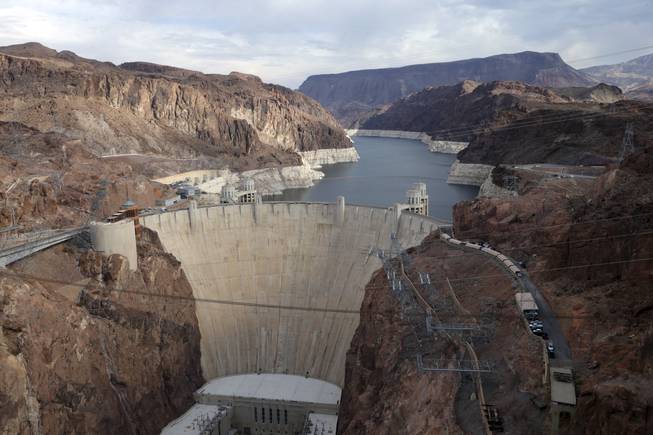
New York Times / Jim Wilson
A view of Hoover Dam and Lake Mead shows canyon walls ringed with white mineral deposits indicating the drop in water levels, near Boulder City, Nev., Dec. 18, 2013.
Friday, April 24, 2015 | 4:17 p.m.
Related stories
The persistent drought that has choked off water flowing into the Colorado River for more than a decade has taken a turn for the worse, with an especially dry winter sending elevation levels at Lake Mead down to their lowest point since the 1930s.
An optimistic start to the year after several large snowfalls in December has evaporated after several months without any appreciable snowfall throughout Utah, Colorado or Wyoming, where runoff from mountain snowpack feeds the Colorado River system that provides 90 percent of Las Vegas's water supply.
"Basically, it's been hotter then a two dollar pistol and drier than a bone," said Randy Julander, a snow survey supervisor with the Department of Agriculture. "It's not just the Colorado River. It's Oregon, California, Washington, Idaho. The entire West has basically been shut out."
The intensification is the latest troubling sign as widespread drought grips the western United States, but declining elevations at Lake Mead won't have any immediate impact on water users in Las Vegas due to expansive conservation measures already in place throughout the region and several expensive construction projects at Lake Mead.
Gov. Brian Sandoval recently announced the formation of a committee to study and plan for the worsening drought, but Nevada isn't facing anything like the mandatory 25 cuts in water usage recently imposed in California.
The most immediate effect of the declining elevation at Lake Mead is the need to extend six boat launch ramps, which are scheduled to begin construction in May at a cost of up to $2 million.
Longer term, the dry winter this year is another step towards critical elevation thresholds that will trigger federal rationing restrictions in the seven states that draw water from the Colorado River. There's always the chance more snowfall in future winters will provide much needed relief to the system - as has happened in 2005 and 2011 - but recent trends indicate water supplies and the reservoirs they feed will continue shrinking.
The situation on the Colorado River has grown progressively worse over the course of this winter, with projections shifting from slightly below average to less than half of average in only a few months.
"It's hard to compare year to year, but this will go down in the annals in history as one of the worst years," Julander said.
In January, officials projected flows into Lake Powell, the large Colorado River reservoir located upstream of Lake Mead, would be 89 percent of average. But that number steadily dropped throughout the winter as no snow materialized, leading to an April projection of only 45 percent of average flows into Lake Powell, a figure that could potentially drop even further when the next projection is made on May 1.
The result is an acceleration of the steady decline at Lake Mead that began when the drought took hold in 2000, when the lake's elevation sat at as high as 1,214 feet. The lake's current elevation is expected to dip a record low on Saturday or Sunday, passing the previous low mark of 1080.19 feet set last August.
The lake is expected to continuing dropping by as much as seven feet to 1,073 feet through July, taking it into a range that hasn't been seen since the reservoir was being filled 78 years ago.
The elevation at Lake Mead is getting dangerously close to the 1,075 foot mark that would trigger federal restrictions to ration water in the four lower basin states that use Colorado River water. That determination won't be made until the Bureau of Reclamation releases its official two-year projections in August and if the rationing is triggered, the cuts wouldn't take effect until January.
Under the rationing, Las Vegas would see its share of Colorado River water cut from 300,000 acre feet per year to 287,000 acre feet per year. But the cuts wouldn't be felt by water users because the region has already implemented widespread conservation measures that have reduced its usage of the Colorado River to about 221,000 acre feet per year.
Further cuts would be implemented when the lake hits 1,050 feet and 1,025 feet, cumulatively reducing Las Vegas' allocation of river water by 7 percent total to 280,000 acre feet per year. Political tensions among the seven Colorado River basin states will heat up as the lake approaches 1,025 feet, a point at which more severe rationing restrictions currently under negotiation will have to be implemented.
But Southern Nevada is prepared to weather declining lake levels due to expensive construction at Lake Mead that will keep water flowing into Las Vegas even as the situation worsens.
The $815 million third intake straw, which draws water from the lake into the water delivery system, is set to begin operating this summer. It will provide a needed buffer and maintain water capacity for when the lake drops below 1,050 feet of elevation, the point at which the first straw becomes non-operational.
The Southern Nevada Water Authority also recently began work on a $650 million low-level pumping station that will be able to send water into the valley even if the lake drops below 1,000 feet in elevation, when two other existing pumping stations will go offline.

Join the Discussion:
Check this out for a full explanation of our conversion to the LiveFyre commenting system and instructions on how to sign up for an account.
Full comments policy